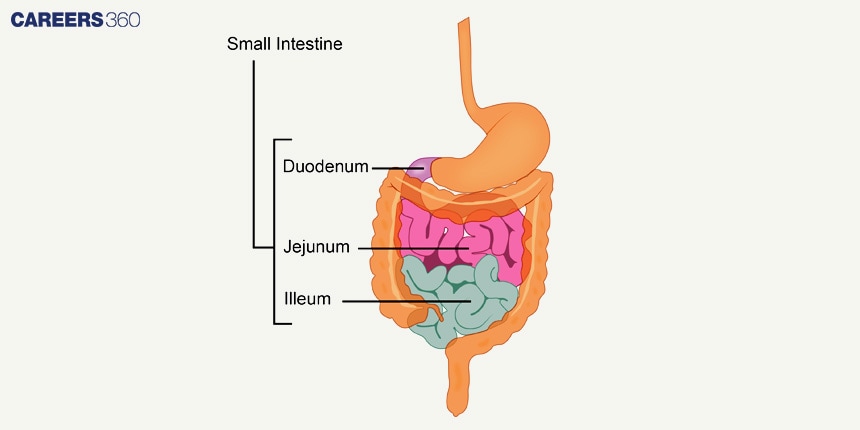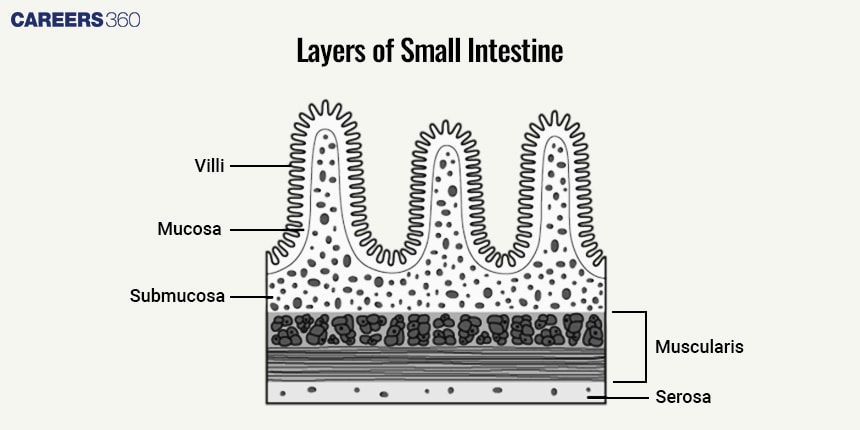Small Intestine: Definition, Functions and Examples
What Is The Small Intestine?
The small intestine represents an important part of the digestive system through which food is received from the stomach and then digested and absorbed. It is a long, coiled tube that starts from the stomach, ends by the large intestine, and extends to a length of about 20 feet. Its long length and structure specialisation let it efficiently process and absorb the needed nutrition for the body's functions.
The small intestine lies in the abdominal cavity, and upon further division, it includes the duodenum, jejunum, and ileum. Various parts of each segment have different roles in digestion, breaking down food, and absorbing it into the bloodstream for utilisation.
Anatomy Of The Small Intestine
Absorption of nutrients requires a great deal of surface area within the small intestine, so its anatomy reflects this need.
Structure And Parts
The small intestine is mainly divided into three parts:
Duodenum
The first part.
Here most of the chemical digestion is done.
Jejunum
The middle part.
Mainly responsible for the absorption of nutrients.
Ileum
The last part.
Responsible for absorption of vitamin B12 and salts of bile.
Diagram: Parts Of Small Intestine

Layers Of Small Intestine
The layers of the small intestine are divided into:
Mucosa
The innermost layer, lined with villi and microvilli
It can increase the surface area for absorption.
Submucosa
A supportive layer containing blood vessels, nerves and glands.
Muscularis externa
Responsible for movements of peristalsis and segmentation.
Serosa
Outermost protective layer.
Diagram: Layers of small intestine
The diagram below shows the four layers of the small intestine.

Surface Area and Villi
Villi and microvilli greatly increase surface area to promote nutrient absorption.
Blood vessels and lymphatics are found in these structures to transport the absorbed nutrients.
Functions Of Small Intestine
The small intestine performs the important functions of digestion and food absorption.
Digestive Functions
Secretion of enzymes: Pancreatic enzymes and enzymes from the intestines break down complex molecules.
Digestion of carbohydrates, proteins, and fats: Carbohydrates are broken down into simple sugar molecules. Proteins are broken down into amino acids; and fats, into fatty acids and glycerol.
Absorptive Functions
Nutrient Absorption: The small intestine absorbs vitamins, minerals, amino acids, and fatty acids.
Transport Mechanisms: Nutrients will be transported through active transport, facilitated diffusion, and osmosis.
Small Intestine Digestive Process
Intrinsically related to other organs, the small intestine's digestive process is paired with definite movements for proper digestion and absorption.
Interrelationship With Other Organs
Pancreas: Adds enzymes such as amylase, protease, and lipase to digest the food.
Liver and gallbladder: Produces and stores bile that emulsifies fats.
Peristalsis And Segmentation
Peristalsis: Rhythmic, wave-like muscle contractions that propel food down the intestine.
Segmentation: Periodic contractions that mix and pulverise food, thereby providing more surface area for absorption.
Health And Diseases Of The Small Intestine
The health of the small intestine is important, for it could be affected by many diseases and disorders.
Common Diseases And Disorders
Celiac disease: An immunological disorder in which the consumption of gluten damages the lining of the small intestine.
Crohn's disease: This is one of the inflammatory bowel diseases that causes inflammation of the digested tract.
Small intestinal bacterial overgrowth (SIBO): Too many bacteria are in the small intestine, causing bloating and diarrhoea, among other symptoms.
Symptoms and diagnosis: Diagnosed by the most common symptoms of abdominal pain, diarrhoea, and malnutrition. Diagnosis may involve blood tests, endoscopy, and imaging studies.
Preventive Measures And Treatment
Dietary recommendations: Ensure to have a balanced diet and an intake that has enough fiber while avoiding particular trigger foods for some conditions.
Medications and therapies: Depending on the condition, treatments may include antibiotics, anti-inflammatory drugs, or immunosuppressants.
Conclusion
The small intestine is one of the most important organs responsible for digestion and absorption of nutrients, which is why life is sustained. Knowledge of anatomy, functions, and health-related problems that afflict this organ, considerably contributes to a healthy digestive system. A balanced diet consumed regularly, supplemented by plenty of fluids and consulting a medical professional if one has issues with the stomach, shall surely guarantee to keep your small intestine in good health.
The Video Recommended On Small Intestine:
Frequently Asked Questions (FAQs)
The major functions of the small intestine are digestion and absorption of food.
There are three portions or parts in the small intestine: duodenum, jejunum, and ileum. Each part has its specific functions.
Celiac disease, Crohn's disease, and small intestinal bacterial overgrowth are some of the diseases related to the small intestine.
Nutrient uptake takes place in the villi and microvilli which line the small intestine, thereby increasing surface area for food absorption.
Common signs of the presence of the infection include abdominal cramps, bloating of the abdomen, very frequent diarrhoea, and malnutrition in some cases. Diagnosis involves medical imaging and laboratory tests.